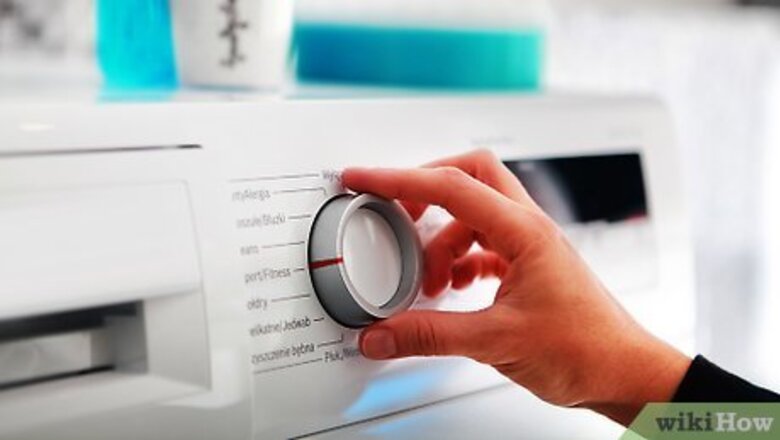
views
Using Color Remover to Prep the Jeans
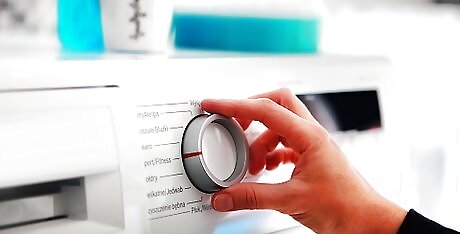
Wash the jeans as you normally would. To ensure that there isn’t any residue that might interfere with the dyeing, wash the jeans you plan to dye beforehand. Place them in the washing machine and wash them as you normally would according to the care instructions. There’s no need to dry the jeans, as they should be wet when you bleach or dye them. If you have blue or light color jeans and you don’t plan to remove the color from them, skip the rest of the steps in this section. The only prep you need to do is wash them.
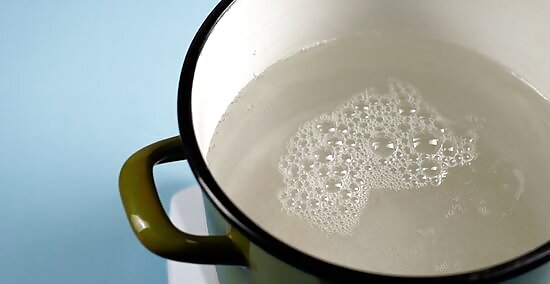
Heat a pot of water to boiling on the stove. Remove the color from colorful jeans, such as red or pink, to create an even base for the black dye. Fill a large stainless steel pot with enough water to completely cover the jeans and set the stove to medium or medium high. Heat the water until it comes to a simmer. Set the jeans aside for now. Don’t place them in the pot while the water is heating. Make sure there is enough room in the pot for the jeans to move around freely. Avoid using an aluminum or nonstick pot. You can substitute a porcelain enamel pot for the stainless steel, though.
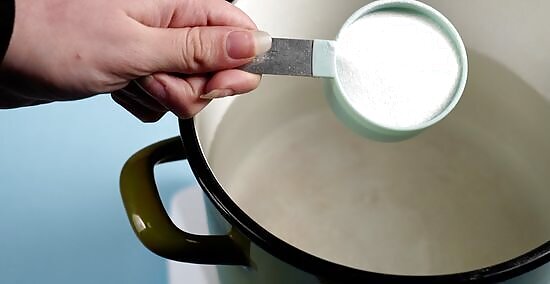
Dissolve the color remover in the water. While you can use regular bleach to take the color out of your jeans, it’s better to use a color-removing product made specifically for pre-dyeing, as it’s gentler on the denim. When the water starts to simmer, add the color remover according to the package instructions and stir until it dissolves completely. Be sure to wear rubber gloves when working with the color remover. Many companies that make fabric dyes also offer color-removing products. Choose one from the same brand as your dye to ensure that they’re compatible. When you’re using the color remover, properly ventilate your kitchen by opening a window or turning on a fan.
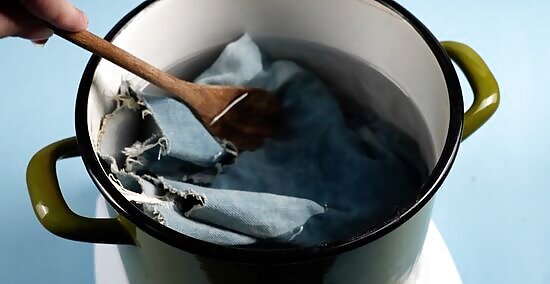
Put the wet jeans in the pot and soak for 30 minutes, stirring regularly. Once the color remover has dissolved in the water, add the wet jeans to the pot. With the water simmering, use a long-handled spoon to stir the jeans continuously for 30 minutes to an hour or until all of the color has been removed from the denim. Make sure that the water doesn’t come to a boil. If it seems like it might, lower the heat. The jeans don’t need to be pure white. They will still take the black dye well if they’re a beige or yellowish color.
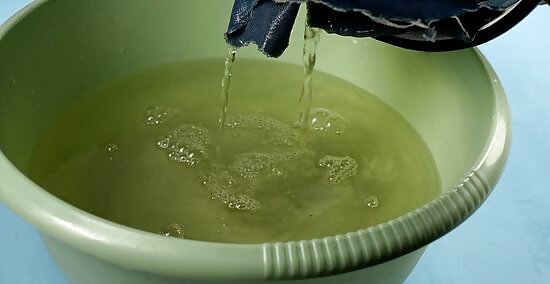
Drain the water from the pot. When the color has been removed from the jeans, turn off the burner. Allow the water to cool for about 5 minutes, then drain it down the sink so the jeans are left alone in the pot. Check the color remover’s label to make sure it’s safe to pour down the sink. You may need to use another disposal method depending on the ingredients.

Rinse the jeans twice and squeeze out the excess moisture. Wear rubber gloves to lift the jeans out of the pot, then rinse them in very hot water from the sink. Next, turn the temperature down so the water is warm and rinse the jeans again. Carefully wring the jeans over the sink to remove the excess water when you’re finished. Don’t use cold or cool water to rinse the jeans, as it may set creases in them.
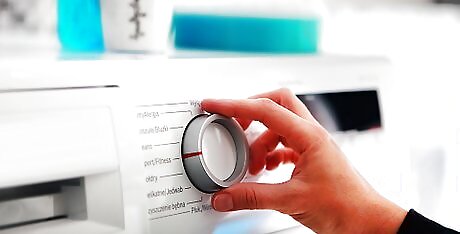
Wash the jeans again using a regular cycle setting. After you’ve rinsed the jeans twice, place them in the washing machine. Wash them as you normally would with detergent to remove any residue. Now, they’re ready for dyeing. Once again, don't dry the jeans after you finish washing them. They should be wet for the next steps.
Readying the Dye

Cover your work area with newspaper or garbage bags. When you’re working with a dark dye, like black, protect your work area so it doesn’t get stained. Use a disposable plastic tablecloth to line the countertops and floor around your stove in case you spill any dye. If you don’t have disposable tablecloths, use plastic wrap or even garbage bags to line the work area. Be sure to wear rubber gloves when you start working with the dye.
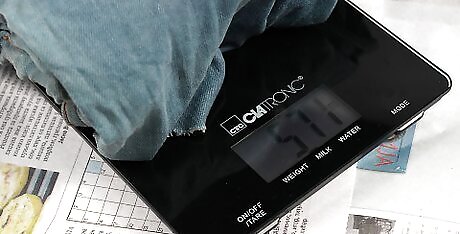
Weigh the jeans so you know how much dye to use. To know how much dye you need, you need to know how much the jeans weigh. Place them on a scale to weigh them and consult the dye’s packaging to determine how much you should use. Most jeans will weigh less than a pound (454 g). In general, you’ll need a full bottle of liquid dye and 2 packages of powder dye to get a dark black color. Consult the dye boxes, though, to determine precisely how much you will need. Buy a little more dye than you think you’ll need. This way, you’ll have extra to darken the dye mixture if necessary.
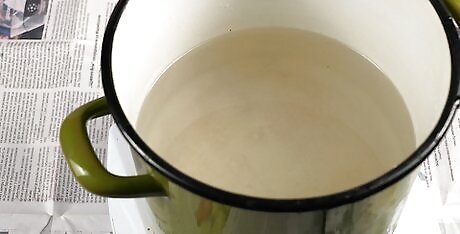
Fill a pot with enough water to cover the jeans, then bring it to a boil. Fill a large pot with enough water to cover the jeans. Then, place it on the stove over medium to medium-high heat and bring the water to a boil. In general, you’ll need 3 gallons (11 L) of water for every pound of fabric that you’re dyeing. There should be enough room in the pot for the jeans to move around freely, so make sure you have a pot that’s large enough. You may want to avoid using a pot you cook with. If you don’t have an old one to use, look for a cheap one at a dollar or thrift store.
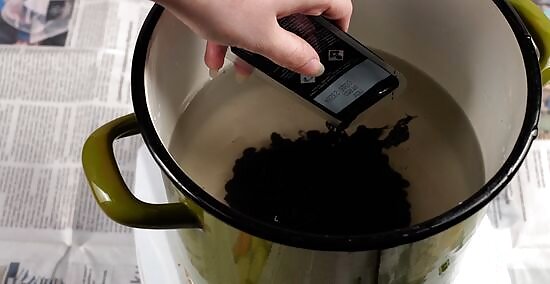
Mix the dye into the water. When the water is simmering, add the dye to the pot according to the manufacturer’s instructions. Stir well to help it blend into the water, then let the mixture simmer for 5 minutes. If you’re using a liquid dye, shake the bottle well before adding it to the water. If you’re using a powder dye, you may need to dissolve it in a cup of hot water before adding it to the pot.
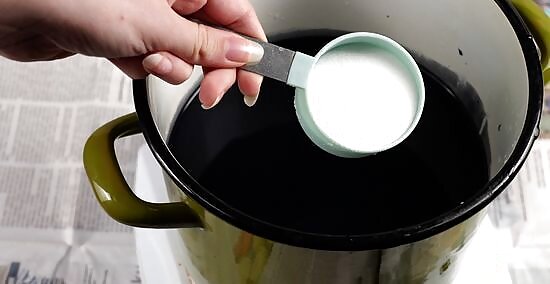
Add ½ a cup (150 g) of salt to the pot. After you’ve mixed in the dye, add salt to the mixture to help the denim absorb the color and promote even dyeing. Consult the manufacturer’s instructions to determine how much salt to add, and stir well so it’s fully incorporated. In general, you’ll probably need about ½ a cup (150 g) of salt.
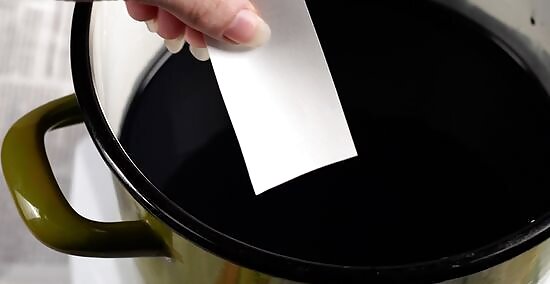
Test the dye with scrap fabric. To ensure that the dye is dark enough to turn your jeans black, dip a light colored scrap of fabric or paper into the pot. Remove it from the water and see if you’re happy with the color. If you’re not, add more dye to the pot and try again until you achieve your desired result. Remember, fabric will look darker when wet than when dry. Let your scrap fabric dry completely so you can see the final result.
Dyeing the Jeans Black
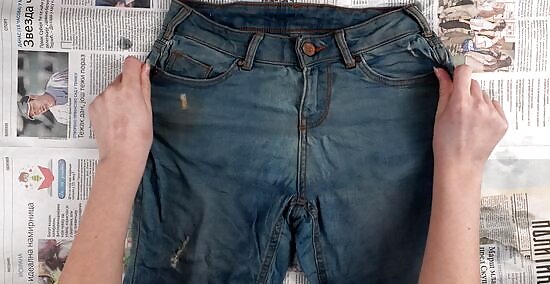
Smooth out any wrinkles from the jeans. Your jeans should still be wet from when you washed them. Before you add them to the pot with the dye, squeeze them one final time to ensure that there isn’t any excess moisture. Then, smooth them out so they’re as wrinkle-free as possible when you add them to the dye.
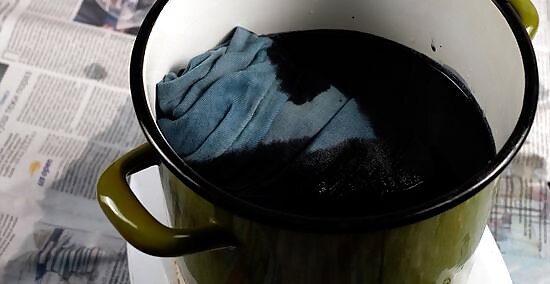
Place the jeans in the pot and stir for at least 30 minutes. When the jeans are smooth, add them to the pot with the dye. Use a long-handled spoon to stir them constantly for at least 30 minutes or until they’re as black as you want. Be sure to move them back and forth and up and down so the dye is absorbed evenly across the denim. Avoid getting the jeans twisted or tangled as you stir, as this can lead to uneven coloring.

Remove the jeans from the dye bath and rinse until the water runs clear. When you’re happy with how black the jeans are, remove the pot from the heat and transfer the jeans to the sink. Rinse them under warm water, then gradually make the water cooler until all of the excess dye has been removed and the water runs clear. Some dye brands also sell a color fixative for cotton fabrics to help prevent fading. You may want to apply some to the jeans right after dyeing. Be sure to follow the manufacturer’s instructions.
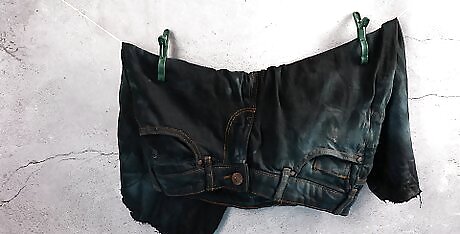
Hand wash the jeans and hang them to air-dry. In the sink, use warm water and a mild laundry detergent to wash the jeans by hand. Rinse them with cool water, then place them on a hanger or clothesline to air dry. Make sure that they’re completely dry before wearing them. If you prefer, you can wash the jeans in a washing machine with an old towel. The towel will absorb any excess dye that comes off the jeans. You can also dry the jeans in a dryer with an old towel to absorb any excess dye.



















Comments
0 comment